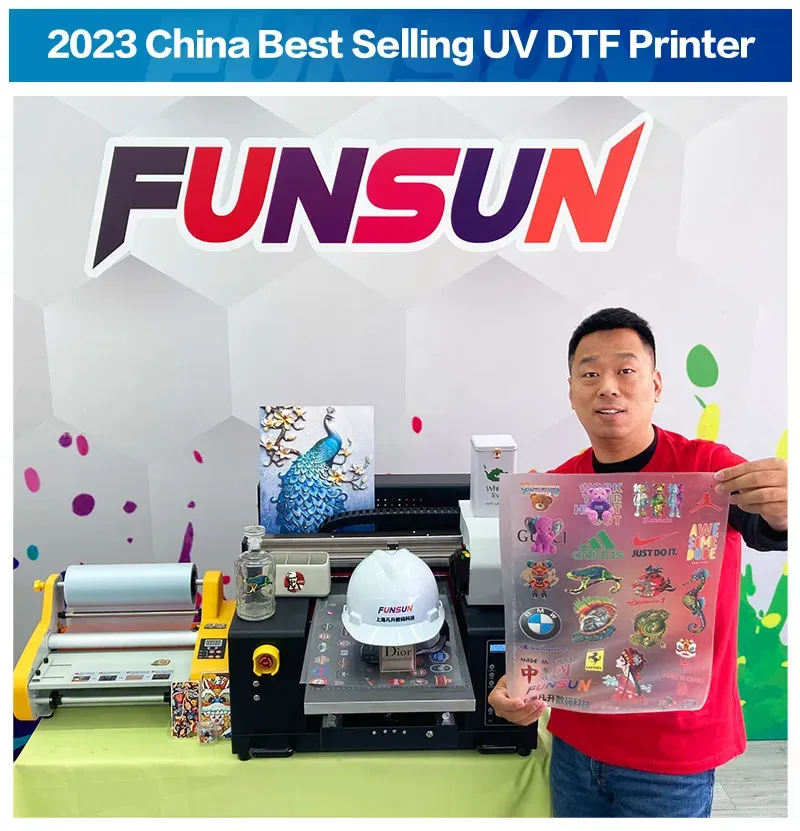UV DTF printing is redefining how we think about garment decoration. By combining the precision of UV-curable inks with the Direct-to-Film (DTF) workflow, it delivers vibrant color, strong adhesion, and faster turnaround times. If you’re a print shop owner, a designer, or a curious hobbyist, understanding this approach can help you decide whether it’s the right fit for your projects. In this guide, we’ll break down the concept, how the DTF transfer process works, and the materials you’ll need, including tips for DTF printing on textiles. You’ll also learn how this technique compares with traditional DTF to optimize color fidelity, durability, and production speed when applying to textiles.
Viewed through a broader lens, this approach blends ultraviolet-curable ink chemistry with a film-based transfer to decorate fabrics. In practice, the process mirrors a digital textile transfer workflow where art is printed on a PET film, cured on the line, and then fused to garments. This method intersects with the ‘DTF transfer process’ concept, offering rapid production, high color saturation, and compatibility with both light and dark fabrics. For designers, it opens up opportunities for on-demand customization and small runs with minimal setup compared to traditional screen or dye-sublimation methods. As you explore options, consider how white ink for DTF and the choice of transfer media influence opacity, texture, and wash durability.
What Is UV DTF Printing and How It Rewrites Garment Decoration
UV DTF Printing represents a merging of ultraviolet-curable inks with the Direct-to-Film (DTF) workflow to redefine garment decoration. By curing inks instantly under UV light, this approach delivers bright color, strong adhesion, and faster turnaround times, even on challenging fabrics. The combination of UV-curable inks and a traditional DTF transfer process creates a robust pathway for designers and print shops who demand reliable durability.
This method is particularly appealing when working with both light and dark fabrics, as a white ink for DTF underprint can help preserve vibrancy on darker textiles. The quick cure reduces handling risk during production and minimizes smudging, making UV DTF Printing a compelling option for high-mix, low-to-mid volume runs and projects that require tight deadlines.
The DTF Transfer Process with UV-Curable Inks: A Step-by-Step Overview
The UV DTF transfer process follows the familiar DTF transfer process steps, but with the crucial addition of UV-curable inks. Start with design and color management to ensure accurate color translation from screen to film, then print onto the PET transfer film with a white ink base for brighter results on dark fabrics. The inks are cured immediately by UV light, fixing the image on the film before any handling.
After curing, a light dusting of adhesive powder is applied and cured to prepare the film for transfer. The final steps involve heating the film onto the garment with a heat press, peeling away the PET film after cooling, and allowing the print to cure fully on the fabric. These stages—immediate UV curing, powder bonding, and controlled heat transfer—define the efficiency and reliability of UV DTF Printing.
Choosing Materials: UV-Curable Inks, White Ink for DTF, and Transfer Films
Selecting the right UV-curable inks is foundational for color fidelity and durability in UV DTF Printing. Ensure compatibility with your printer model and confirm that the inks cure cleanly under your UV curing unit. The white ink for DTF underprint is essential for achieving brightness on dark textiles and maintaining color depth across the transfer.
Pair these inks with a PET transfer film designed for UV inks and a suitable powder adhesive system. A high-quality white ink layer can improve opacity, while the transfer film must tolerate the curing process and support clean peel-age after transfer. Flexibility in film choice and adhesive powder application directly impacts the overall look and longevity of the final garment print.
Color Management and Printing on Textiles: Achieving Vibrant Results
Effective color management ensures that what you design on screen translates accurately to textiles through DTF printing on textiles. Calibrate your color profiles, monitor settings, and ICC profiles for each fabric type to maintain consistency across runs. The rapid curing of UV inks helps preserve color saturation, but accurate prepress setup remains essential for predictable outcomes.
A strong white ink underprint on dark fabrics is often necessary to preserve brightness under vibrant UV-curable inks. Testing opacity, ink thickness, and layer order helps avoid cracking or dull tones, especially on blends and synthetics. By aligning the dye-sub-like expectations with the DTF workflow, you can achieve true-to-design results with reliable colorfastness.
Best Practices for Fast Turnarounds and Durable UV DTF Prints
To maximize throughput, standardize the workflow with a stable UV curing unit and consistent exposure across the print bed. Regular calibration and color management checks, especially when changing fabrics, help maintain reproducible results. Optimizing white ink underprints and powder adhesion ensures brighter colors and stronger transfer bonds on various textiles.
Fine-tuning heat transfer parameters—temperature, pressure, and dwell time—affects adhesion and fabric feel. Start with manufacturer recommendations and conduct controlled test prints to avoid over-curing or under-curing issues. Proper post-transfer care, including a brief cure after cooling, further enhances durability and wash resistance of UV DTF prints.
Troubleshooting, Maintenance, and Longevity of UV DTF Transfers
Common issues in UV DTF transfers, like fading colors or chalky whites, often stem from insufficient white ink underprint coverage or inconsistent curing. Revisit opacity settings and ensure uniform UV exposure across the entire film to prevent hotspots or uneven color. Regularly inspect the curing unit and replace any aging UV lamps to maintain color accuracy.
Maintenance is key for longevity: clean print heads and rollers, store films in a dry environment to prevent clumping, and run periodic test prints to catch drift in adhesion or curing efficiency early. Troubleshooting should include checking film tension, powder application, and transfer surface cleanliness to avoid bonding failures and curling after transfer.
Frequently Asked Questions
What is UV DTF Printing and how does it differ from traditional DTF?
UV DTF Printing is a Direct-to-Film method that uses UV-curable inks. The inks cure instantly under UV light, speeding up handling and reducing the risk of smudging, unlike traditional DTF that relies on water-based inks that air-dry. This often yields vibrant color on both light and dark fabrics, especially when supported by a white ink for DTF underprint on dark textiles.
What materials and equipment do I need for UV DTF Printing?
Key items include UV-curable inks compatible with your printer, a PET transfer film designed for UV inks, white ink for DTF underprinting, powder adhesive, a UV curing unit (or integrated curing lamps), and a reliable heat press. You’ll also want proper color management tools and testing substrates for fabric varieties.
How does the UV DTF transfer process work from design to finished garment?
The process starts with a color-managed design, then UV DTF printing applies UV-curable inks to a PET transfer film with a white ink base on darker fabrics. The film is UV-cured, a powder adhesive is applied and cured, the film is pressed onto the garment with heat, and finally the film is peeled away after cooling and curing.
Which fabrics are best suited for UV DTF Printing on textiles?
UV DTF Printing works well on a range of textiles, including cotton, blends, and polyester. Dark fabrics benefit from a solid white ink for DTF underprint to maintain brightness and color vividness, while light fabrics showcase strong saturation from the UV-curable inks.
What are the main benefits and potential drawbacks of UV DTF Printing vs traditional DTF?
Benefits include faster curing and handling due to UV-curable inks, vibrant colors with good colorfastness, and a potentially simpler workflow. Drawbacks to consider are higher equipment and material costs, more rigorous dust and film handling with powder adhesion, and variations in fabric feel depending on the adhesive and post-transfer curing.
How can I maximize durability and color accuracy with UV DTF Printing?
Best practices include calibrating color for each fabric type, controlling the UV curing exposure for uniform curing, optimizing white ink underprints on dark fabrics, applying powder evenly, and following precise heat transfer parameters. Proper post-transfer care and testing help ensure long-lasting results with UV-curable inks.
| Aspect | Summary |
|---|---|
| What is UV DTF Printing | A variation of Direct-to-Film that uses UV-curable inks; inks cure instantly under UV light, reducing wait times and minimizing smudging, while delivering bright colors and strong adhesion. |
| How it Works | Design and color management; print onto PET transfer film with white base on dark fabrics; UV cure; apply adhesive powder; cure powder; heat transfer to fabric; post-transfer curing and care. |
| Materials & Equipment | UV-curable inks; PET transfer film; white ink; powder adhesive; UV curing unit; heat press; powder handling tools; testing substrates. |
| Pros | Faster curing; vibrant color and colorfastness; potentially simpler workflow; durable adhesion; works on light and dark fabrics. |
| Cons | Higher equipment and material costs; powder handling adds steps and clean-up; potential fabric feel after transfer; regular calibration and maintenance required. |
| Best Practices | Calibrate color for each fabric; control curing for uniform exposure; optimize white underprint; apply powder evenly; fine-tune heat transfer parameters; post-transfer cure and care. |
| Workflow Variations | Inline UV curing versus two-step curing; effects on throughput, footprint, and defects; enforce QA at every stage from file to finished product. |
| UV DTF vs Traditional DTF | Ink chemistry (UV-curable vs water-based); curing method (instant UV vs air-drying); handling and film robustness; color outcomes; overall cost considerations. |
| Care & Longevity | Follow garment care guidelines; store films and powders dry; clean equipment; run periodic tests to monitor color/adhesion and curing. |
| Troubleshooting | Fading, chalky whites, cracking after wash, uneven curing, powder residue, or film curling; remedies include adjusting white base, improving curing, powder application, and transfer conditions. |
| Careers, Costs, and the Right Fit for Your Business | Assesses fabrics, volumes, and turnaround; pilot with test designs; compare total cost per unit, color accuracy, and durability to decide if UV DTF suits your shop. |
Summary
UV DTF Printing represents a compelling bridge between rapid production and high-quality textile decoration. By leveraging UV-curable inks and a robust DTF workflow, designers and printers can achieve bright, durable prints on a wide range of fabrics, including light and dark materials. Like any production method, success depends on the right combination of equipment, materials, process control, and post-transfer care. With thoughtful setup, regular testing, and adherence to best practices, UV DTF printing can deliver reliable results, enabling you to expand your product offerings and meet growing customer demand for fast, vibrant custom apparel and accessories.



